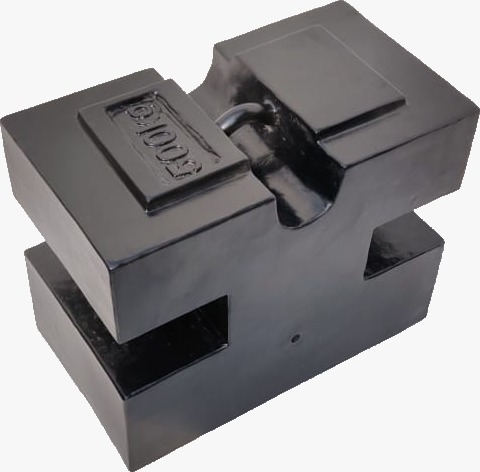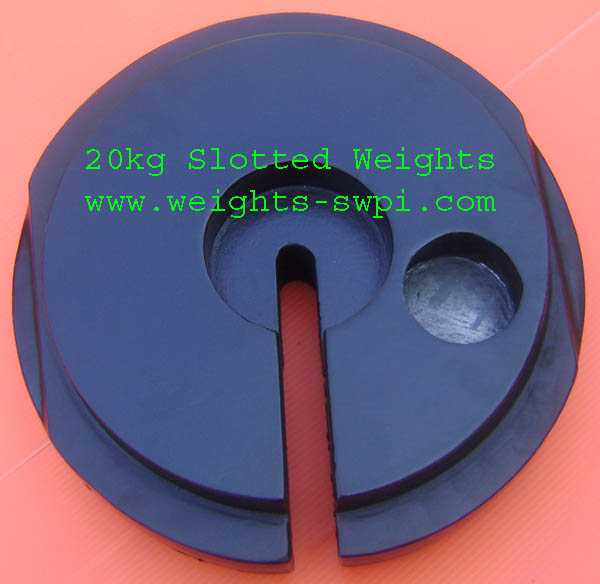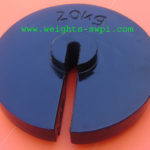Rhineland-Palatinate, one of the 16 States of the Federal Republic of Germany (surface area about 20 000 km2 – population four million) has about 1 200 truck scales. This means that a large number of initial verifications and (at 3-yearly intervals) subsequent verifications have to be carried out. According to the corresponding European Union recommendations, the initial verification may be carried out by the manufacturer if a recognized quality management system is used, provided that the process is supervised by the Verification Authority.
Market surveillance, i.e. the question of how the truck scales will metrologically function over a long period of time, is carried out by the Verification Authority. One tool is subsequent verification every third year, using standard weights that have been tested by the Authority. However, the verification of truck scales requires the use of weights with large nominal values (between 100 kg and 1 000 kg) and in order to move such heavy weights, auxiliary equipment has to be installed on the truck.
In principle it is imaginable that platform weighing machines may be tested without weights using hydraulic load installations, though up to now nobody has developed such a system. Nowadays almost all balances are provided with electronic equipment that can be tested relatively easily in the Verification Authority laboratory. However, this cannot substitute a complete check with standard weights at the site of a truck scale. This means that for truck scales to be verified, weights will still have to be transported, moved and loaded on site in the future.
This article concerns a Rhineland-Palatinate Verification Authority vehicle that has been in service for some years (see article in the OIML Bulletin No. 114, March 1989) and which was completely modified about two years ago; meanwhile much experience has been gathered with this new verification vehicle. A normal truck can be used for the construction of a verification vehicle, but with the following special features incorporated:
- Small distance between axles, so that high loads can be moved even onto small weighbridges;
- High-powered engine, so that the vehicle can be driven on public roads without slowing down other traffic (despite its heavy weight);
- Remote-controlled hydraulic crane;
- Supports that can be raised by hydraulic jacks for safe operation of the crane;
- Additional hydraulic supports for lifting up the truck’s front axle, so that the necessary weights can be loaded even on very short weighbridges;
- The ratio of the standard weights compared to the weight of the truck when empty should be about 1:1. In this case the application of the substitution method according to OIML Recommendation R 76 is simple; and
- Removable top cover for easy unloading of the weights. For the verification vehicle in question (Fig. 1) all these aspects have been taken into account and therefore:
Fig. 1 Verification vehicle. On the tractor: 25 rolling weights (500 kg each);
on the trailer: 15 t block weights, forklift and passenger car
- The distance between axles is 4.55 m. Additional hydraulic supports are mounted behind the front wheels to lift up the front axle (Fig. 2);
Fig. 2 Additional hydraulic support for lifting up the front axle
- Engine power is 368 kW (500 bhp); and
- Maximum crane load (depending on the working radius) is between 1.6 t and 0.5 t for 3.6 m up to 8 m (Fig. 3)
Fig. 3 Unloading two rolling weights using a remote-controlled crane
Fig. 4 Trailer: block weights beneath the passenger car and to the right and left of the forklift, which is standing on the loading area
The crane is operated by remote control, and the truck is equipped with supports which can be hydraulically drawn out when the crane is operating; the handling platform is equipped with an awning.
The loading area of the truck serves for the transport of weights of 12.5 t in the form of 500 kg cylindrical weights. The empty weight of the truck is also 12.5 t, therefore the maximum weight is 25 t.
In order to be able to perform the testing procedure as prescribed, the necessary rolling weights have to be manipulated on the bridge without the use of any mechanical device after they have been unloaded using the crane. However, it transpired that there are not enough auxiliary personnel able to move the heavy weights and that the latter involve a high accident risk when they start rolling unintentionally (in Germany two people were killed by rolling weights).
The former truck scales verification equipment was equipped with rolling weights only. To counter the aforementioned problems, the trailer has been modified to cater for the safe handling of rolling weights. However, the tractor itself is still equipped with rolling weights just in case this facility is required under special circumstances.
The trailer was custom-designed so that it can also be used for the verification of small weighbridges; for this purpose supports are mounted on the trailer directly behind the front axle so that the trailer fits on a weighbridge of 4.10 m in length. The trailer has a total weight of 30 t, of which 15 t are standard block weights of 200 kg, 500 kg and 1 000 kg (Fig. 4). Because of the supports on the tractor and trailer it is possible to verify weighbridges even with very short platforms, i.e. a total load of 55 t (Fig. 5) on a weighbridge of length 8.80 m and a load of 44 t on a weighbridge of length 5 m.
Fig. 5 Rear view of the trailer
Using block weights reduces the risk of accidents, but on the other hand the disadvantage is that they cannot be moved manually so this is done by a forklift with a loading capacity of 3 t. The forklift is used for loading and unloading the trailer (Fig. 6) as well as for positioning and removing weights on particular spots of the weighbridge according to the verification officer’s instructions (Fig. 7).
Fig. 6 Unloading a 1 t block weight
The forklift is stored along with the trailer and is operated by the driver of the verification vehicle – therefore external auxiliary personnel for moving the weights are no longer necessary.
Fig. 7 Moving standard weights to special spots on the weighbridge
When work with the forklift is finished, it is put back on the trailer using two ramp rails which can be moved up and down hydraulically. Since the forklift cannot mount such a steep ramp by itself, it is pulled up by an electric winch (Fig. 8). The remote control for this winch is operated by the driver of the forklift.
Fig. 8 Forklift pulled up by a winch
On a rack above the block weights there is also space to store a small car (Fig. 4). This has the advantage that the verification vehicle, which due to its exceptionally high load of 55 t is only allowed to use public roads with special authorization, can directly drive from one operation to the next. For all other trips – for example to a verification office or back home – the driver uses this car. Consequently the verification vehicle itself is only used when absolutely necessary.
Fig. 9 Car driving up
Fig. 10 Car in its final position on the trailer (beneath the car, winch for pulling up the forklift)
The car has to be small enough to fit on the trailer, and since most of the time it is only used by one person, this does not pose a problem. The car in question is a Fiat Cinquecento with 40 kW (55 bhp) which is able to mount the two ramp rails (Figs. 9 and 10).
If necessary, the driver may spend the night in the driver’s cab, which is quite comfortable. He can be reached at any time using a mobile phone.
The cylindrical and block weights on these vehicles are all standard weights and are tested and adjusted every six months by the Verification Authority. As permissible tolerances, the mpe in accordance with OIML R 47 is applied.
The running costs for the verification vehicle are 1 180 DM per day. If this is considered too high, the weights may be picked up at the Verification Office by the truck scale owner, who must ensure that he is equipped with a forklift, a crane and, of course, a truck to transport the weights. He must also use his own personnel to move and place them, and must later return them to the Verification Office.
The Rhineland-Palatinate Authority verification vehicle is fully booked throughout the year, except when repairs and maintenance work have to be carried out. The percentage of annual utilization is actually greater than 100 % since weighbridges are not only verified on weekdays but also on some weekends (on 23 Saturdays and Sundays in 1998). Weekend operation can be necessary because some companies cannot put their weighing instruments out of operation for a long time for maintenance and verification (on average 1.5 days) during the week. Therefore, they prefer to pay an extra charge for the weekend service.
A verification vehicle costs about 680 000 DM to purchase; annual income is about 290 000 DM less operating costs but including maintenance costs. This means that the vehicle costs are depreciated after approximately 8 years.
The verification vehicle (including the driver) is selffinancing – financial support is only necessary from the government for the initial capital – therefore outright purchasing is highly recommended.
The verification vehicle is also occasionally used for testing truck scales during the 3-year period. This is a chance to study the metrological behavior of road vehicle weighers during this period until the next subsequent verification is due.
Private companies own similar vehicles for testing truck scales and it is up to the owner of the truck scale whether he uses a privately operated vehicle or if he prefers the Verification Office one, but the periodical reverification itself is always carried out by an inspector of the Verification Authority.
WOLFHARD GÖGGE and DETLEF SCHEIDT, Verification Authority of Rhineland-Palatinate, Bad Kreuznach, Germany
For your requirements of High Denominational Weights, you may contact:
www.weights-swpi.com



 Magazine: Weights & The Society
Magazine: Weights & The Society 